Holiday 2010 System Builder's Guide
by AnandTech Staff, edited by Jarred Walton on November 19, 2010 2:00 AM EST- Posted in
- Guides
- Systems
- Holiday 2010
| Brian's Intel Dream PC | ||
| Hardware | Component | Price |
| Processor |
2x Intel Xeon X5660 Westmere 32nm (Hex-core + HTT, 2.8 to 3.2 GHz, 12MB L3, 95W) |
2x $1225 |
| CPU HSF | 2x Xigmatek Dark Knight-S1283V | 2x $45 |
| Motherboard |
EVGA Classified SR-2 (Intel 5520, ICH10R, 270-WS-W555-A2) |
$590 |
| GPU | 2x EVGA SuperClocked GTX 580 | 2x $530 |
| Hard Drives | 4x Western Digital 1.5TB (WD1501FASS) | 4x $120 |
| OS Drive (SSD) | OCZ RevoDrive X2 240GB PCI-E 4x SSD | $680 |
| Memory | 2x Patriot 12GB (3x4GB) DDR3 1333 | 2x $360 |
| Power Supply | Antec TPQ-1200 80 Plus Silver | $250 |
| Case | Lian Li PC-V2120X ATX Full Tower | $500 |
| Optical Drive | LG 10x Blu-Ray Burner w/Lightscribe | $100 |
| Keyboard | Das Keyboard Professional Model S Silent | $135 |
| Alt Keyboard | Logitech G510 Keyboard | $100 |
| Mouse | Razer Mamba 5600 DPI Wired/Wireless | $130 |
| Monitor | Dell U3011 30" 2560x1600 IPS | $1350 |
| Sound Card | Creative 7.1 24-bit PCI-E X-Fi Titanium | $75 |
| Total System Price | $8610 | |
When I heard that the whole AnandTech staff was going to get to put together a rig of their choice, I instantly gravitated to the super high end. Heck, there's no reason you can't at least ask for the absolute best, even if you know it's out of your price range. For others, maybe you really do want to go sky high and push the limits of what's possible with desktop parts without getting too exotic. Either way, this dream machine build isn't for the faint of heart.
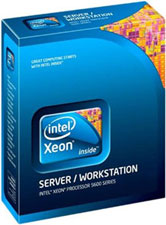
I've configured and built a number of dual processor Xeon 56xx series workstations in the past, yet each time destined for a fairly mundane existence doing computational modeling or some other serious business. Each time I'm finished, there's a brief but overwhelming temptation to install Crysis, Metro 2033—heck, something!—with all the eye candy on max with a 2560x1600 display. Each time, I shake that thought away right after finishing burn-in testing as I pop in the latest version of whatever *nix flavor is appropriate. I kid myself that maybe eventually I'll be able to build something like this without having to justify every bit of it as being vitally critical for modeling complicated scientific something or other. Anyway, if you've got nearly limitless piles of sweet cash lying around, this is the rig for you.
Starting out is really the motherboard. Initially, I wanted to go with a server-class motherboard, the SupermicroMBD-X8DTi, having worked with it and similar workstation boards in the past. If you want a dual CPU motherboard, the options basically dictate either a similar class of "server" motherboard like theMBD-X8DTi from Supermicro, something comparable from Tyan, or the only choice in the more conventional desktop class of products, the EVGA Classified SR-2. TheMBD-X8DTi and SR-2 are actually quite similar; both are built around the Intel 5520 and ICH10R chipsets, both are happy with an unreasonable number of triple 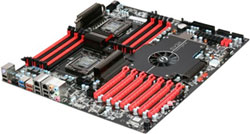 channel ECC or non-ECC DDR3-1333 memory, and both actually present similar PCI-E lane configurations. The Supermicro comes with onboard graphics, but we'd obviously recommend disabling that in the BIOS and forgetting about it. The Supermicro board costs $430, whereas the Classified SR-2 costs a slightly mind-bending $590. The difference between the two is ultimately whether you want SLI licensing so you can stick in some some multi-GPU goodness from NVIDIA. Remember that NVIDIA still requires either a BIOS key or NVIDIA bridge chip for SLI to work, both of which the cheaper Supermicro board lacks. AMD CrossFire remains feasible on both, but that difference, along with the more enthusiast-oriented features like overclocking support, ultimately led me to settle on the SR-2, despite its nose-bleed-inducing price tag.
channel ECC or non-ECC DDR3-1333 memory, and both actually present similar PCI-E lane configurations. The Supermicro comes with onboard graphics, but we'd obviously recommend disabling that in the BIOS and forgetting about it. The Supermicro board costs $430, whereas the Classified SR-2 costs a slightly mind-bending $590. The difference between the two is ultimately whether you want SLI licensing so you can stick in some some multi-GPU goodness from NVIDIA. Remember that NVIDIA still requires either a BIOS key or NVIDIA bridge chip for SLI to work, both of which the cheaper Supermicro board lacks. AMD CrossFire remains feasible on both, but that difference, along with the more enthusiast-oriented features like overclocking support, ultimately led me to settle on the SR-2, despite its nose-bleed-inducing price tag.
Of course, now that we've incurred such a large price premium to get a two-socket motherboard, we should stick in at least a couple hex-core CPUs, right? Two 6-core CPUs with Hyper-Threading gives a whopping 24 threads of power. For that, there's Intel Westmere—the SR-2 andMBX-X8DTi both support Xeon 5500 and 5600 series. At the most extreme, there's the 3.33GHz Xeon 5680, which runs $1725, but anyone can sort by price and see what's the most expensive, and we're still at least somewhat interested in performance per buck (or are we?) The Xeon 5680 can Turbo from 3.33GHz to 3.6GHz. Subjectively, the Xeon X5660 seems to be a better tradeoff between price and stock clock speed at 2.8GHz, plus you get a larger turbo boost up to 3.2GHz. Either way, the two CPUs will set you back a big chunk of change. As one reader pointed out, you also need a heatsink for Xeon, as it doesn't ship with one, so we grabbed a couple of Xigmatek Dark-Knight coolers.
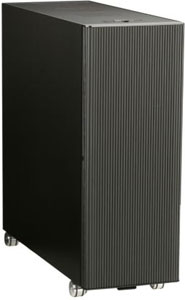
In the traditional workstation configuration, I usually opt for a Cooler Master Cosmos or Cosmos S, and when I think about what's really ultimate in the case market these days, my mind immediately settles on either the iconic Thermaltake Level 10 or the ABS Canyon 695. TheMBD-X8DTi and other workstation boards are E-ATX, which would fit in all the aforementioned cases but the Level 10. Unfortunately, the SR-2 is enormous and necessitated EVGA to define their own motherboard form factor entirely—HPTX—which is a mind-numbing 13.6" x 15". The result is that our case recommendation is limited unless you're willing to go custom or break out the Dremel. Luckily, there's a line of HPTX cases by Lian Li that are attractive and fit the SR-2 just fine. If you're opposed to finding a motherboard tray properly machined for HPTX or loath to do modifications yourself, the Lian Li PC-V2120X is what you should go for.
Moving along we come to the GPUs; I talked with Ryan on this to get his input, and ultimately we both agreed on 2xSLI GTX 580s. EVGA is (at time of this writing) offering the Superclocked version at 797MHz core/1594MHz shader clocks for prices on par with the competition's regularly clocked GTX 580s. The choice is simple at that point: go for the factory overclocked EVGA while it's still feasible.
Storage on a dream build would be incomplete without an SSD for the OS. Thankfully, the RevoDrive X2 is indeed bootable and thus makes an ideal drive for the OS and critical system apps. On every system I've built in recent memory, I've gone with an SSD + RAID array of slow but capacious storage; I think the same is best here. Get four or five 1.5TB or higher HDDs of whatever brand makes you feel warmest inside, toss them in a RAID5 set, and enjoy a crap-ton of storage that's fully redundant. I suppose if you're really feeling ultimate, you could get a RAID card instead of using the ICH10R's software fakeRAID, but it probably isn't critical unless you want to eek out everything you can from those mechanical drives.
My dream PC would be incomplete without at least 12GB of RAM—it's just that simple. I think it's safe to say that 6GB is pretty standard for midrange X58 gaming builds, with 8GB and 12GB starting to become the norm at the fringes. To stay safely ahead, you've got to move to 24GB, which is actually surprisingly common for workstations processing huge datasets that need to exist entirely in RAM. Of course, it's more than likely that no game will ever make use of the 24GB, but we're building the ultimate system here, right? The objective is to play Crysis within Crysis if we could. I settled on two sets of matched Patriot 12GB (3x4GB) kits, as all the 24GB (3x8GB) kits I could find were either sold out or lacked heat spreaders. You should still get triple-channel performance on either the SupermicroMBD-X8DTi or EVGA SR-2 with six populated memory slots, but it definitely makes me a little uneasy populating so many if you don't have lots of airflow.
For the power supply, we're big fans of the Antec TPQ-1200 Silver, which packs a half and half modular/fixed set of cables. It's a combination that provides the best of both worlds for not blocking airflow with unused power cables, and fixed cables for being absolutely certain connectors aren't a concern. The TPQ-1200 is (as the name implies) 1200W, which should be adequate for the SR-2, two Xeons, and two GTX 580s, plus all those mechanical drives.
I'm a fan of LG's 10x Blu-ray burner with LightScribe support, purely because it's SATA, well received, and I've built a number of systems with it in the past. You get DVD+/-R support at 16x, and CDR support at 48x, which is pretty standard. I'm a sucker for LightScribe support just because I always convince myself that the next batch of writeable disks I buy will also be LightScribe; sadly, I've somehow avoided ever doing it. Regardless, the optical drive is quickly becoming marginalized, but for your ultimate build, why not include one? Same thing with the sound card—you don't really need one anymore if onboard audio suffices, but if we're going for the ultimate, you might as well consider it.
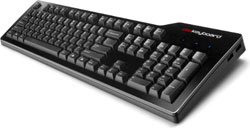
Since we're going all out, we'd be remiss if we didn't include suggestions for the peripherals as well. When I think of the ultimate keyboard, I immediately think of one keyboard—the Das Keyboard. If you haven't heard of it, chances are you've been living under a rock, or been blind sighted by all the flashy gaming-focused keyboards with copious amounts of LED lights but little attention to the mechanics of keydomes. If you want a gaming keyboard, get the Logitech G510—it's awesome and I have one—but if you're serious about typing, consider the Das Keyboard. Das Keyboard is essentially the modern IBM model M equivalent, and is a joy to type on purely because of the serious mechanical and aural feedback. For the mouse, I'm a huge fan of Razer. I worked my way from the Logitech MX1000 (the first laser mouse) through a number of Logitech and Razer mice alike, but keep settling back down on Razer. It's ultimately a matter of personal taste.
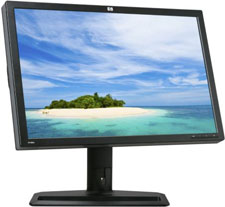
Last but certainly not least is the monitor. The choices here are quite obvious: either buy a 30" Dell U3011 or its archrival, the HP ZR30w. Both are IPS, both look superb, and both round out the dream configuration. Or maybe you need two 30-inchers? I've left out a fan recommendation since the stock fans for these Xeons have (thus far) seemed sufficient, but the usual Zalman 120mm or similar are always an option I'd encourage.
This configuration is again insane, but at the end of it all, I still find myself thoroughly convinced that if I had infinite monies, I'd put it together in a heartbeat—and maybe even splurge for that 3.33GHz Xeon 5680, regardless of the fact that it's overkill even for Crysis. If you had infinite cash or an appetite for the drooling-on-the-carpet insane—and need it right stinkin' now—this is the system I'd recommend, right after I note that Sandy Bridge is right around the corner. If this configuration is financially justifiable to you, by all means, do it! (And send us some benchmarks and pictures!) Alas, for me, it's still little more than a holiday dream.










112 Comments
View All Comments
JarredWalton - Friday, November 19, 2010 - link
While it would be great if Bulldozer could run in current motherboards, all the information I've been able to gather (including asking a contact at a motherboard manufacturer) is that Bulldozer for desktops will run in AM3r2. That socket will be similar to AM3, and it will be able to accept and run current AM3 processors, but the reverse isn't true. So, in essence it's the AM2+ situation again.If you search AMD's site, there's no mention of AM3r2 that I can find outside of their forums. It's still possible that we're mistaken, but AMD hasn't unequivocally stated that "yes BD will work in current motherboards" so I wouldn't count on it. I think originally the idea was to try and make it happen, but now it's not guaranteed.
If you really want to go to the rumor mill, BD might actually work in current boards but might blow caps or have reduced performance. Maybe someone will come out with a fix. All indications however are that there will be new chipsets (980/990 most likely), a new socket requirements, etc. I guess it may be a lot like the socket 775 transitions from Intel where we had a few manufacturers that got older 945P chipsets to run Core 2 and such.
JarredWalton - Friday, November 19, 2010 - link
Just to add a bit more: Phenom X6 will technically work in many 790FX motherboards... but it's not the same as running it in an 890FX. 790FX wasn't designed for Turbo Core, it has some power management issues with Thuban, etc. We have seen similar issues with previous updates where a CPU would work, but it didn't perform optimally. We may see that with Bulldozer as well, where it will run in 800 series boards with a BIOS update but it very likely will run best with a new motherboard/chipset. If AMD and their partners can prove me wrong, I'd be very pleased, but based on at least one source I'm not holding out much hope.blotto5 - Saturday, November 20, 2010 - link
thanks for the info good to know since im running a phenom x6 in a 790fx mobo but i think im going to wait to buy a new mobo because of this talk of a new socket a la am2 to am2+baba264 - Friday, November 19, 2010 - link
This comes quite handy as after the death of my graphic card two days ago, I was seriously thinking of buying a new system that would be quite similar to "Ryan's High-End Gaming System".However, when I had previewed the various parts I wanted, I had set my mind on a new lynnfield core with an i7 870 rather than the old Bloomfield core. Since I don't plan to upgrade to an SLI setting I thought that the i7 870 was the best choice of processor (for the price), was I mistaken?
Anyway, thanks for the article, this article really comforts me in what I meant to buy.
Ryan Smith - Friday, November 19, 2010 - link
The 870 is quite good. In fact when I was putting that list together I was seriously considering that instead of an X58 platform. The clincher was SLI support (P55 boards with SLI quickly drive the price up); but since you're not going to be using SLI I wouldn't be concerned.mapesdhs - Friday, November 19, 2010 - link
P55 boards run very nicely SLI, easily outperforming X58 boards, and that's
with an 860, never mind an 870. See my results pages:
http://www.sgidepot.co.uk/misc/pctests.html
http://www.sgidepot.co.uk/misc/stalkercopbench.txt
Further tests coming soon with an 870 + GTX 460 FTW SLI.
it's only really 3-way SLI where X58 takes over. For 2-way, the speeds
are just as good (if not better) and the costs are significantly lower - the
board I'm using costs less than 70 UKP ($110).
Ian.
JarredWalton - Friday, November 19, 2010 - link
Color me confused, but those links don't seem to provide the data you're talking about. The question is how something like i7-930 with X58 compares to i7-860 with P55 while everything else is kept constant, and all the stuff there looks like 930 + 4870 CF or 460 SLI, and 860 + 8800 GT SLI, or some other sets of data. You'd need to show X58 460 SLI vs. P55 460 SLI to "prove" that P55 is "easily outperforming X58 boards". And if you do everything with similar quality components, the X58 ought to win out by virtue of having two x16 connects compared to two x8 connects on P55.mapesdhs - Friday, November 19, 2010 - link
(my friend has 4890s, not 4870s)
I'm surprised you'd say that given existing articles have already
shown that SLI doesn't need full 16x to perform nicely. Some games
need it because they're written badly (FSX), but others run perfectly
well at 8X, or even 4X.
Specific data coming soon (still testing) but my point was that the
existing data already shows the same effect - people on forums
said the 4890s should win, but they don't much of the time except
where resolution, etc. are a factor.
I'm still ploughing through my P55/460 tests. All takes time as I'm
sure you can appreciate. :)
Ian.
JarredWalton - Friday, November 19, 2010 - link
I'm not saying X58 is substantially faster by any means; I'm just saying that all things being equal there's no reason P55 should be faster. x8 vs. x16 isn't a huge benefit, but especially with higher clocked CPUs and more powerful GPUs (i.e. GTX 580 or HD 5870) the X58 should come out ahead. Anyway, Gary Key did a pretty direct comparison when he was still with us:http://www.anandtech.com/show/2847
In general X58 CF is better than P55 CF, though the margin is never so large as to be alarming. What Gary doesn't show is how the SLI setups compare (probably for lack of an SLI capable P55 board at the time he was with us). I'd figure they're also similar. All told, P55 is faster for single GPUs, but the x8+x8 dual-GPU configuration should and usually does incur a small performance hit.
mapesdhs - Saturday, November 20, 2010 - link
Generally true, though remember the one advantage which
can make a difference sometimes (and push it in favour
of P55) is the better Turbo on the 870, etc. For fixed
clocks, have a look at the CPU scores I get with the
860 at 4018 for the 3DMark06 CPU tests, compare to
my friend's 930 at 4136 (and btw, it's not RAM speed;
I lowered my RAM to match, scores only dropped 1
or 2%).
You're right though about the top-end cards/CPUs, if
I was playing at crazy res with expensive cards like
the 580 then X58 would be more logical. For midrange
though, like the 460 (with or without SLI), the gain from
X58 is minimal at best - the cost difference (which
may be large) can be used to have a better GPU,
widening the gap further.
And by cost difference I mean, for example, the Asrock
P55 Deluxe, which is now as cheap as 68 UKP here.
It has excellent slot spacing for SLI, ie. better cooling.
Either way, we shall see; after doing default tests, my
plan is to run the FTWs at lower clocks to match my
friend's Palit Platinums, that should be interesting.
All I'm saying is, don't be surprised if P55/SLI runs
better than you might expect. I certainly didn't think
two 8800GT SLI would be able to match or beat
an X58 with two 4890s, but they can and do.
Ian.